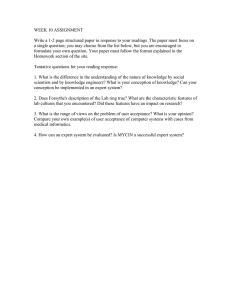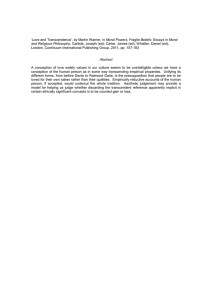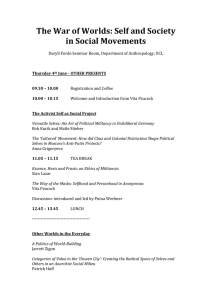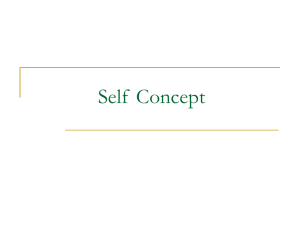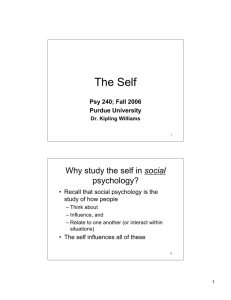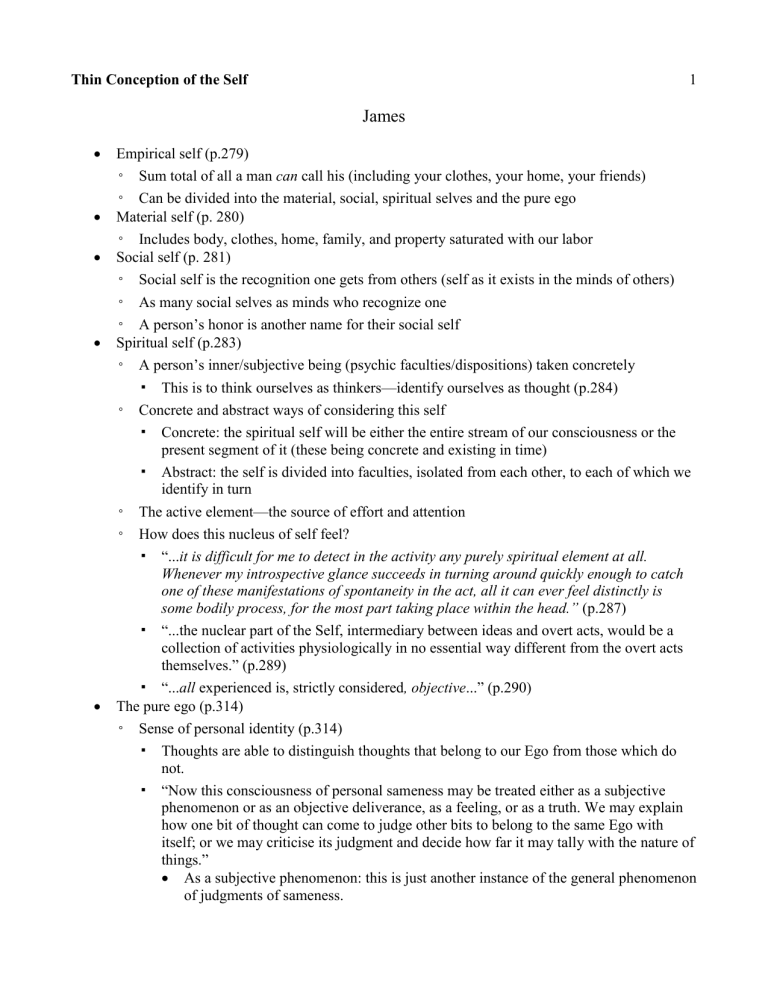
Thin Conception of the Self 1 James Empirical self (p.279) ◦ Sum total of all a man can call his (including your clothes, your home, your friends) ◦ Can be divided into the material, social, spiritual selves and the pure ego Material self (p. 280) ◦ Includes body, clothes, home, family, and property saturated with our labor Social self (p. 281) ◦ Social self is the recognition one gets from others (self as it exists in the minds of others) ◦ As many social selves as minds who recognize one ◦ A person’s honor is another name for their social self Spiritual self (p.283) ◦ A person’s inner/subjective being (psychic faculties/dispositions) taken concretely ▪ This is to think ourselves as thinkers—identify ourselves as thought (p.284) ◦ Concrete and abstract ways of considering this self ▪ Concrete: the spiritual self will be either the entire stream of our consciousness or the present segment of it (these being concrete and existing in time) ▪ Abstract: the self is divided into faculties, isolated from each other, to each of which we identify in turn ◦ The active element—the source of effort and attention ◦ How does this nucleus of self feel? ▪ “...it is difficult for me to detect in the activity any purely spiritual element at all. Whenever my introspective glance succeeds in turning around quickly enough to catch one of these manifestations of spontaneity in the act, all it can ever feel distinctly is some bodily process, for the most part taking place within the head.” (p.287) ▪ “...the nuclear part of the Self, intermediary between ideas and overt acts, would be a collection of activities physiologically in no essential way different from the overt acts themselves.” (p.289) ▪ “...all experienced is, strictly considered, objective...” (p.290) The pure ego (p.314) ◦ Sense of personal identity (p.314) ▪ Thoughts are able to distinguish thoughts that belong to our Ego from those which do not. ▪ “Now this consciousness of personal sameness may be treated either as a subjective phenomenon or as an objective deliverance, as a feeling, or as a truth. We may explain how one bit of thought can come to judge other bits to belong to the same Ego with itself; or we may criticise its judgment and decide how far it may tally with the nature of things.” As a subjective phenomenon: this is just another instance of the general phenomenon of judgments of sameness. Thin Conception of the Self 2 “The sense of personal identity… is the sense of sameness perceived by thought and predicated of things thought-about.” (p.315) That we have this sense of self does not mean that it is true that we are the same selves that we were yesterday (p. 316) The thought is right when it comes to the fact that there was a past self with past thoughts, and right too when it comes to the fact that there is a present self. The question is what it comes to when it judges that it is the same self. We feel the past and present selves that have warmth and intimacy are the ones that belong to us. (p.317) The selves thought identifies as the same have a mark of continuity. “And if from the one point of view they are one self, from others they are as truly not one but many selves.” (p.318) ▪ “Each Thought is thus born as an owner, and dies owned, transmitting whatever it realized as its Self to its own later proprietor. As Kant says, it is as if elastic balls were to have not only motion but knowledge of it, and a first ball were to transmit both its motion and its consciousness to a second, which took both up into its consciousness and passed them to a third, until the last ball held all that the other balls had held, and realized it as its own.” (p.322) Thought=the present mental state ▪ “The passing Thought then seems to be the Thinker.” (p.324) Pure self/inner principle of personal unity (p.324) ◦ Spiritualist theory of the Ego (p325) ▪ “The theory of the Soul… declares that the principle of individuality within us must be substantial, for psychic phenomena are activities, and there can be no activity without a concrete agent. This substantial agent cannot be the brain but must be something immaterial… Thought moreover is simple, whilst the activities of the brain are compounded of the elementary activities of each of its parts. Furthermore, thought is spontaneous or free, whilst all material activity is determined ab extra; and the will can turn itself against all corporeal goods and appetites, which would be impossible were it a corporeal function.” (p.325) ▪ The soul is not needed to express the actual subjective phenomena of consciousness as they appear (they can be formulated with the supposition of a stream of thought) (p.326) Summary (p.378) ◦ “The I… cannot itself be an aggregate… It is a Thought, at each moment different from that of the last moment, but appropriative of the latter, together with all that the latter called its own.” (p. 379) Selves (Strawson) Some conceptions of selves: ◦ thick conception: human beings and other sentient creatures considered as whole are the subjects of experience Thin Conception of the Self 3 ◦ traditional inner conception: a subject of experience is some sort of persisting inner locus of consciousness, an inner someone, an inner metal presence ◦ thin conception: a subject of experience is something that exists only if experience exists of which it is the subject ▪ a synergy subject: the goings on that wholly constitute its existence and experience consists entirely of activity in the brain Assumption: gaps in experience exist Some identities: ◦ 1 [s=e] ◦ 2 [e=c] ◦ 3 [s=c] ◦ 4 [e=s=c] ◦ 5 [e=s:c] ◦ 6 [e=s(c)] ◦ 7 [e ↔ s ↔ c] Points from Descartes: ◦ Subjects can’t exist in absence of experience ◦ Thinking (general sense) is identified as conscious thought ◦ There’s no real distinction between a thing and its attributes or properties ◦ There’s no real distinction between the concrete existence of a thinking substance and the concrete existence of the attribute of thinking The problem of ontic depth ◦ Given a thin conception of the self, how does one account for the real existence of the understanding, memory, etc.? ▪ Leibnizian suggestion that there is more than one locus of consciousness (pp.348-349) [e=s=c] ◦ The counterfactual argument: Why can’t we say the subject is distinct from the content since, after all, the content the subject has might not have been what it turned out to be? ▪ The counterfactual invariability of e, s, and c is guaranteed ◦ Central strangeness is the identification of c and s ◦ The terminological decision: whether to say that subjects of experience persist when there is no experience (p.412) ◦ The replacement argument: What of the possibility of the subject coming into existence but the content switching (no gap in experience) while the same subject persists? ▪ The change is content doesn’t allow the sameness of subjects

